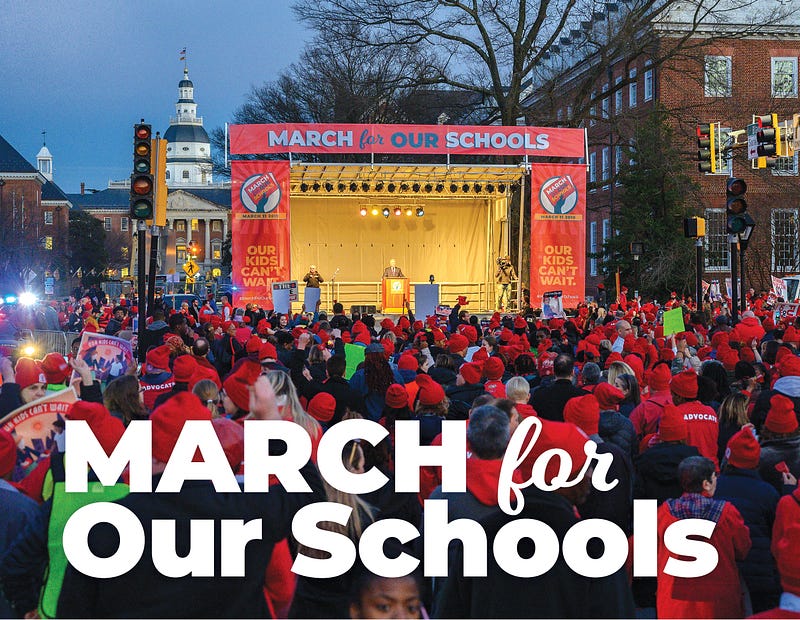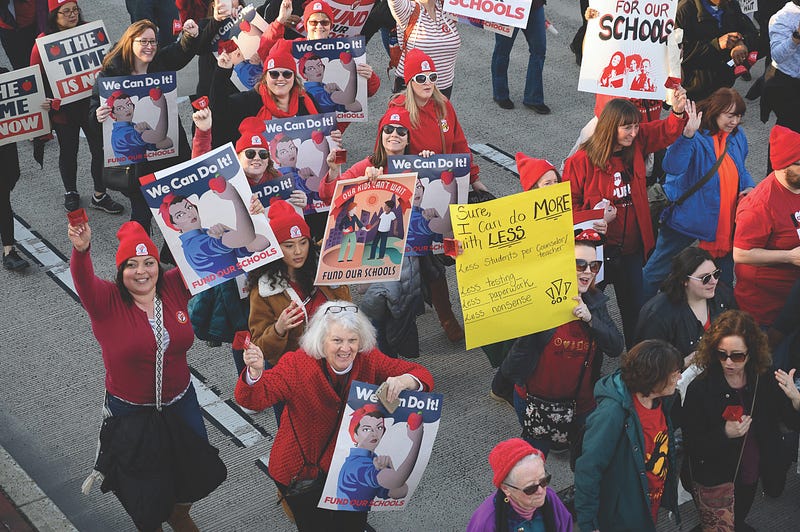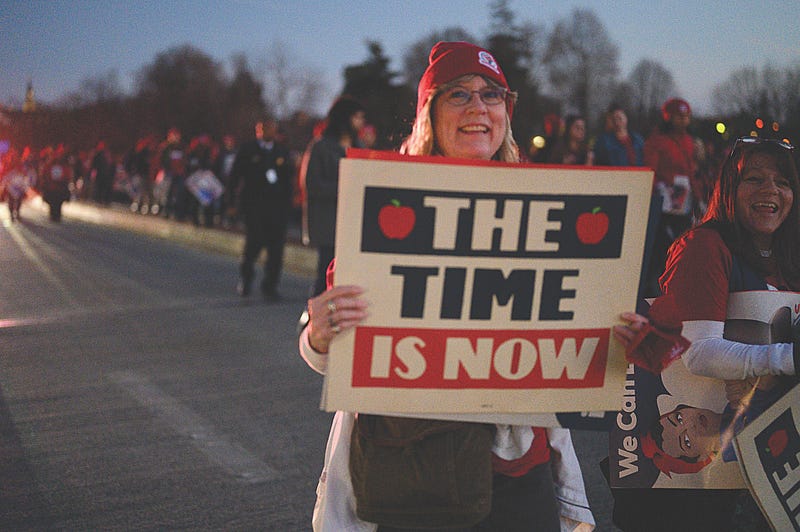We Marched — and Won $1 Billion for Schools
Here’s what it means for your school.

We’ve been working very hard for this. MSEA’s non-stop multi-year education funding campaign has focused on providing as much input, influence, and support as possible to the state’s updating of the school funding formula for the first time in 20 years. It’s a once-in-a-generation opportunity to re-think and re-prioritize the needs of Maryland’s students, educators, and communities and we must take full advantage of it.
Since an independent analysis determined that Maryland schools were annually underfunded by $2.9 billion, Maryland educators have been showing up and insisting on a brighter future for their kids. They’ve showed up at the hundreds of 10-minute meetings local building reps held across the state. They’ve showed up at town halls to be heard by policymakers. They’ve showed up at the General Assembly to share their stories and their experiences on the front lines of education. They’ve responded to calls to action and become activists.
And they showed up 8,500 strong at the March for Our Schools to demand legislators take action. More student services. More support professionals. More funding for special education and behavioral health. More community schools. Better, more competitive salaries. They showed up for fairness, equity, and compassion.
The success of the march and the overwhelming, bipartisan passage of the Blueprint for Maryland’s Future — which adds $1 billion to our schools over the next three years — is a huge win. Those efforts will need to continue at the state and local levels throughout 2019 and in the 2020 legislative session to educate the public, policymakers, and voters about the importance of continuing the work of the Kirwan Commission and actions to advance the next phase of the Blueprint.

“This incredible victory shows what’s possible when we use our collective voice and power to stand up for our schools,” said MSEA President Cheryl Bost. “It’s also a sign of things to come — we’re going to keep it up and keep fighting for the funding and programs that we need until they become a reality.
“Our kids can’t wait, and I’m proud of all the members who are advocating for what we know our students deserve now.”
The Blueprint for Maryland’s Future
$1.1 Billion Increase in State School Funding over Next Three Years
The Kirwan Commission recommended an 11-year implementation timeline between now and 2030, with funding ultimately increasing by $3.8 billion annually (split between the state and county governments).
The Blueprint for Maryland’s Future provides a $255 million increase in 2019–2020, $355 million in 2020–2021, and $500 million in 2022. That totals $1.1 billion and puts the Blueprint on a gradual path to be implemented on schedule. The funding increases are paid for by a combination of casino revenue promised thanks to the passage of Question 1 in the 2018 election, a $200 million set-aside in the 2019 budget, and an adjustment to the online sales tax.
Teacher Salaries Increase by 4.5% Next School Year
One of the major findings of the Kirwan Commission was just how underpaid teachers are in Maryland compared to those in high-performing school systems — both internationally and in the United States. So the Commission recommended that Maryland increase its teacher salaries by 10% above normal rates of increase in the next three years: 3% in 2019–2020, 3% in 2020–2021, and 4% in 2021–2022.
Since teacher salaries in Maryland have increased by an annual average of about 1.5% since 2012–2013, that means teachers would need to see a 4.5% increase to realize the commission’s recommendation. The legislation makes this happen by providing an additional 1.5% raise if school systems provide a 3% increase (the 1.5% usual increase and a 1.5% local bump). All certificated educators in teacher bargaining units (but not administrators) are eligible for the raise.

Expanded Pre-K
There is $32 million included to convert more half-day pre-kindergarten for low-income four-year-olds to full-day. This is estimated to grow to $59 million in the 2020–2021 school year with further expansion. These are the first steps towards a targeted public pre-kindergarten program that covers all three- and four-year-olds below 300% of the poverty line at no cost, as well as four-year-olds between 300–600% of the poverty line for a sliding scale fee.
Special Education and More
The bill contains $65 million to fund special education services in both the 2019–2020 and 2020–2021 school years. School districts are not required to fund any specific strategies so long as the funding is used to fully implement individualized education plans and 504 plans. But with special educators severely overworked, it would be smart for districts to use additional funding to hire more special education staff.
The legislation includes $23 million to fund in-school tutoring services for K-3 students performing below grade level in English or math. It’s very possible that school districts will hire additional paraeducators to provide this one-on-one and small group tutoring.
Mentors, Career Ladders, Mental Health Support
The Blueprint includes $2.5 million to incentivize the creation of new teacher mentorship programs and teacher career ladders, and $2 million to fund a mental health services coordinator in every school district.

200+ New Community Schools
As the commission wrestled with how to close opportunity gaps between low-income students and their more affluent peers, a consensus quickly grew around the community school model.
The commission recommended that every school with low-income students making up 55% or more of its student population would receive funding for a community school coordinator and a health services practitioner.
The legislation begins phasing in that idea, starting with schools that have low-income students making up 80% or more of their student population. That means 219 schools will qualify next school year — mostly in Baltimore City and Prince George’s County. Fifteen other counties will receive funding for at least one school next year.
An Inspector General
The Blueprint includes an important feature not in the Kirwan recommendations. It’s a new office of an inspector general created to investigate instances of fraud, waste, and abuse in schools. The bill also creates a separate auditing process for districts to demonstrate they are using the funding for the specific policies outlined in the law — for example, ensuring that money meant for salary increases isn’t going to hire more central office staff.
What’s Next?
We’ve come very far in just two years. From our campaign to Fix the Fund to the March for Our Schools, MSEA members have joined educators across the country by championing the needs of our students and demanding respect for our professions. We’ve already won more than $1 billion in new funding. But there is work still to do.
“On the state level, in January 2020 the General Assembly is expected to revise the state’s school funding formula for the first time in nearly 20 years. This is the next step in the Blueprint for Maryland’s Future — a huge opportunity to ensure that every school and student in every zip code gets the funding they deserve for years to come,” said MSEA President Cheryl Bost.
“On the local level, we’ll need to work for strong funding commitments and make the most of these new opportunities to improve salaries, increase staffing, and implement the types of programs that we know students need,” Bost added. “Now’s the time to get involved in your local’s contract and issue campaigns to make these changes a reality in your school.”


